Long-Term Changes of the Wildland–Urban Interface in the Polish Carpathians
Abstract
1. Introduction
2. Study Areas in the Polish Carpathians
3. Materials and Methods
4. Results
4.1. Land Use and WUI Changes over Time
4.2. Conterfactual Scenarios to Identify Causes of WUI Growth
5. Discussion
6. Conclusions
Acknowledgments
Author Contributions
Conflicts of Interest
References
- Radeloff, V.C.; Hammer, R.B.; Stewart, S.I.; Fried, J.S.; Holcomb, S.S.; McKeefry, J.F. The Wildland-Urban Interface in the United States. Ecol. Appl. 2005, 15, 799–805. [Google Scholar] [CrossRef]
- Hammer, R.B.; Radeloff, V.C.; Fried, J.S.; Stewart, S.I. Wildland-urban interface housing growth during the 1990s in California, Oregon, and Washington. Int. J. Wildland Fire 2007, 16, 255–265. [Google Scholar] [CrossRef]
- Lampin-Maillet, C.; Long-Fournel, M.; Ganteaume, A.; Jappiot, M.; Ferrier, J.P. Land cover analysis in wildland-urban interfaces according to wildfire risk: A case study in the South of France. For. Ecol. Manag. 2011, 261, 2200–2213. [Google Scholar] [CrossRef]
- Lampin-Maillet, C.; Jappiot, M.; Long, M.; Bouillon, C.; Morge, D.; Ferrier, J.-P. Mapping wildland-urban interfaces at large scales integrating housing density and vegetation aggregation for fire prevention in the South of France. J. Environ. Manag. 2010, 91, 732–741. [Google Scholar] [CrossRef] [PubMed]
- Conedera, M.; Tonini, M.; Oleggini, L.; Vega Orozco, C.; Leuenberger, M.; Pezzatti, G.B. Geospatial approach for defining the Wildland-Urban Interface in the Alpine environment. Comput. Environ. Urban Syst. 2015, 52, 10–20. [Google Scholar] [CrossRef]
- Argañaraz, J.P.; Radeloff, V.C.; Bar-Massada, A.; Gavier-Pizarro, G.I.; Scavuzzo, C.M.; Bellis, L.M. Assessing wildfire exposure in the Wildland-Urban Interface area of the mountains of central Argentina. J. Environ. Manag. 2017, 196, 499–510. [Google Scholar] [CrossRef] [PubMed]
- Buxton, M.; Haynes, R.; Mercer, D.; Butt, A. Vulnerability to Bushfire Risk at Melbourne’s Urban Fringe: The Failure of Regulatory Land Use Planning. Geogr. Res. 2011, 49, 1–12. [Google Scholar] [CrossRef]
- Van Wilgen, B.W.; Forsyth, G.G.; Prins, P. The Management of Fire-Adapted Ecosystems in an Urban Setting: The Case of Table Mountain National Park, South Africa. Ecol. Soc. 2012, 17, 108. [Google Scholar] [CrossRef]
- Larsen, A.E.; MacDonald, A.J.; Plantinga, A.J. Lyme disease risk influences human settlement in the wildland-urban interface: Evidence from a longitudinal analysis of counties in the northeastern United States. Am. J. Trop. Med. Hyg. 2014, 91, 747–755. [Google Scholar] [CrossRef] [PubMed]
- Bar-Massada, A.; Radeloff, V.C.; Stewart, S.I. Biotic and Abiotic Effects of Human Settlements in the Wildland-Urban Interface. Bioscience 2014, 64, 429–437. [Google Scholar] [CrossRef]
- Evans, M.J.; Rittenhouse, T.A.G.; Hawley, J.E.; Rego, P.W. Black bear recolonization patterns in a human-dominated landscape vary based on housing: New insights from spatially explicit density models. Landsc. Urban Plan. 2017, 162, 13–24. [Google Scholar] [CrossRef]
- Loss, S.R.; Will, T.; Marra, P.P. The impact of free-ranging domestic cats on wildlife of the United States. Nat. Commun. 2013, 4, 1396. [Google Scholar] [CrossRef] [PubMed]
- Ibisch, P.L.; Hoffmann, M.T.; Kreft, S.; Pe’er, G.; Kati, V.; Biber-Freudenberger, L.; DellaSala, D.A.; Vale, M.M.; Hobson, P.R.; Selva, N. A global map of roadless areas and their conservation status. Science 2016, 354, 1423–1427. [Google Scholar] [CrossRef] [PubMed]
- Joint, E.F. Landscape Fragmentation in Europe; EEA Report; Europe Environment Agency: Copenhagen, Denmark, 2011; ISBN 9789292132156. [Google Scholar]
- Gavier-Pizarro, G.I.; Radeloff, V.C.; Stewart, S.I.; Huebner, C.D.; Keuler, N.S.; Gavier-Pizarro, G.I.; Radeloff, Á.V.C.; Stewart, S.I.; Huebner, C.D.; Keuler, N.S. Rural housing is related to plant invasions in forests of southern Wisconsin, USA. Landsc. Ecol. 2010, 25, 1505–1518. [Google Scholar] [CrossRef]
- Sullivan, J.J.; Timmins, S.M.; Williams, P.A. Movement of exotic plants into coastal native forests from gardens in northern New Zealand. N. Z. J. Ecol. 2005, 29, 1–10. [Google Scholar]
- Gaston, K.J.; Bennie, J.; Davies, T.W.; Hopkins, J. The ecological impacts of nighttime light pollution: A mechanistic appraisal. Biol. Rev. 2013, 88, 912–927. [Google Scholar] [CrossRef] [PubMed]
- Balmori, A. Electromagnetic pollution from phone masts. Effects on wildlife. Pathophysiology 2009, 16, 191–199. [Google Scholar] [CrossRef] [PubMed]
- Platt, R.V. The Wildland-Urban Interface: Evaluating the Definition Effect. J. For. 2010, 108, 9–15. [Google Scholar]
- Sirca, C.; Casula, F.; Bouillon, C.; García, B.F.; Fernández Ramiro, M.M.; Molina, B.V.; Spano, D. A wildfire risk oriented GIS tool for mapping Rural-Urban Interfaces. Environ. Model. Softw. 2017, 94, 36–47. [Google Scholar] [CrossRef]
- Chas-Amil, M.L.; Touza, J.; García-Martínez, E. Forest fires in the wildland-urban interface: A spatial analysis of forest fragmentation and human impacts. Appl. Geogr. 2013, 43, 127–137. [Google Scholar] [CrossRef]
- Gurung, A.B.; von Dach, S.W.; Price, M.F.; Aspinall, R.; Balsiger, J.; Baron, J.S.; Sharma, E.; Greenwood, G.; Kohler, T. Global Change and the World’s Mountains—Research Needs and Emerging Themes for Sustainable Development. Mt. Res. Dev. 2012, 32, S47–S54. [Google Scholar] [CrossRef]
- Kaim, D.; Kozak, J.; Kolecka, N.; Ziółkowska, E.; Ostafin, K.; Ostapowicz, K.; Gimmi, U.; Munteanu, C.; Radeloff, V.C. Broad scale forest cover reconstruction from historical topographic maps. Appl. Geogr. 2016, 67, 39–48. [Google Scholar] [CrossRef]
- Bucała-Hrabia, A. Long-term impact of socio-economic changes on agricultural land use in the Polish Carpathians. Land Use Policy 2017, 64, 391–404. [Google Scholar] [CrossRef]
- Chapron, G.; Kaczensky, P.; Linnell, J.D.C.; von Arx, M.; Huber, D.; Andrén, H.; López-Bao, J.V.; Adamec, M.; Álvares, F.; Anders, O.; et al. Recovery of large carnivores in Europe’s modern human-dominated landscapes. Science 2014, 346, 1517–1519. [Google Scholar] [CrossRef] [PubMed]
- Kaim, D. Land cover changes in the Polish Carpathians based on repeat photography. Carpath. J. Earth Environ. Sci. 2017, 12, 485–498. [Google Scholar]
- Kowalewski, J.; Mordasewicz, J.; Osiatyński, J.; Regulski, J.; Stępień, P.; Śleszyński, P. Raport o Ekonomicznych Stratach i Społecznych Kosztach Niekontrolowanej Urbanizacji w Polsce; PAN IGiPZ: Warszawa, Poland, 2013. [Google Scholar]
- Kozak, J. Forest Cover Changes and Their Drivers in the Polish Carpathian Mountains Since 1800. In Reforesting Landscapes: Linking Pattern and Process; Nagendra, H., Southworth, J., Eds.; Landscape Series; Springer Netherlands: Dordrecht, The Netherlands, 2010; Volume 10, pp. 253–273. ISBN 978-1-4020-9656-3. [Google Scholar]
- Munteanu, C.; Kuemmerle, T.; Boltiziar, M.; Butsic, V.; Gimmi, U.; Lúboš, H.; Kaim, D.; Király, G.; Konkoly-Gyuró, É.; Kozak, J.; et al. Forest and agricultural land change in the Carpathian region—A meta-analysis of long-term patterns and drivers of change. Land Use Policy 2014, 38, 685–697. [Google Scholar] [CrossRef]
- Kozak, J.; Estreguil, C.; Troll, M. Forest cover changes in the northern Carpathians in the 20th century: A slow transition. J. Land Use Sci. 2007, 2, 127–146. [Google Scholar] [CrossRef]
- Kaim, D. Zmiany pokrycia terenu na pograniczu polsko-słowackim na przykładzie Małych Pienin. Prz. Geogr. 2009, 81, 93–106. [Google Scholar] [CrossRef]
- Affek, A. Spatially explicit changes in land ownership through 3 socio-political systems: A case study from southeast Poland. Geogr. Pol. 2015, 88, 519–530. [Google Scholar] [CrossRef]
- Angelstam, P.; Elbakidze, M.; Axelsson, R.; Čupa, P.; Halada, L.; Molnar, Z.; Pătru-Stupariu, I.; Perzanowski, K.; Rozulowicz, L.; Standovar, T.; et al. Maintaining Cultural and Natural Biodiversity in the Carpathian Mountain Ecoregion: Need for an Integrated Landscape Approach. In The Carpathians: Integrating Nature and Society Towards Sustainability; Kozak, J., Ostapowicz, K., Bytnerowicz, A., Wyżga, B., Eds.; Springer: Berlin/Heidelberg, Germany, 2013; pp. 393–424. ISBN 978-3-642-12724-3. [Google Scholar]
- Mika, M. Spatial Patterns of Second Homes Development in the Polish Carpathians. In The Carpathians: Integrating Nature and Society Towards Sustainability SE 35; Kozak, J., Ostapowicz, K., Bytnerowicz, A., Wyżga, B., Eds.; Springer: Berlin Heidelberg, Germany, 2013; pp. 497–512. ISBN 978-3-642-12724-3. [Google Scholar]
- Timár, G.; Biszak, S.; Székely, B.; Molnár, G. Digitized Maps of the Habsburg Military Surveys—Overview of the Project of ARCANUM Ltd. (Hungary). In Preservation in Digital Cartography; Springer: Berlin/Heidelberg, Germany, 2010; pp. 273–283. [Google Scholar]
- Feurdean, A.; Munteanu, C.; Kuemmerle, T.; Nielsen, A.B.; Hutchinson, S.M.; Ruprecht, E.; Parr, C.L.; Perşoiu, A.; Hickler, T. Long-term land-cover/use change in a traditional farming landscape in Romania inferred from pollen data, historical maps and satellite images. Reg. Environ. Chang. 2017, 17, 2193–2207. [Google Scholar] [CrossRef]
- Munteanu, C.; Kuemmerle, T.; Boltiziar, M.; Lieskovský, J.; Mojses, M.; Kaim, D.; Konkoly-Gyuró, É.; Mackovčin, P.; Műller, D.; Ostapowicz, K.; et al. Nineteenth-century land-use legacies affect contemporary land abandonment in the Carpathians. Reg. Environ. Chang. 2017, 17, 2209–2222. [Google Scholar] [CrossRef]
- Kaim, D.; Kozak, J.; Ostafin, K.; Dobosz, M.; Ostapowicz, K.; Kolecka, N.; Gimmi, U. Uncertainty in historical land-use reconstructions with topographic maps. Quaest. Geogr. 2014, 33, 55–63. [Google Scholar] [CrossRef]
- Dz.U. Rozporządzenie MSWiA z Dnia 17 Listopada 2011 r. w Sprawie Bazy Danych Obiektów Topograficznych Oraz Bazy Danych Obiektów Ogólnogeograficznych, a Także Standardowych Opracowań Kartograficznych; Dziennik Ustaw: Warsaw, Poland, 2011. [Google Scholar]
- Dobosz, M.; Kozak, J. Problem integracji danych przestrzennych na przykładzie szacowania współczesnej powierzchni lasów w Karpatach Polskich. In XXV Konferencja PTIP; Biblioteka Narodowa: Warsaw, Poland, 2015. [Google Scholar]
- Reinfuss, R. Próba charakterystyki etnograficznej Rusi Szlachtowskiej na podstawie niektórych elementów kultury materialnej. Lud 1947, 37, 160–235. [Google Scholar]
- Troll, M.; Ostafin, K. Use of late 18th and early 19th century cadastral data to estimate past forest cover change—A case study of Zawoja village. Pr. Geogr. 2016, 146, 31–49. [Google Scholar] [CrossRef]
- Kubijowicz, W. Życie pasterskie w Beskidach Magórskich. Pr. Kom. Etnogr. PAU 1927, 2, 1–65. [Google Scholar]
- Sobala, M.; Rahmonov, O.; Myga-Piatek, U. Historical and contemporary forest ecosystem changes in the Beskid Mountains (southern Poland) between 1848 and 2014. iFor. Biogeosci. For. 2017, 10, 939. [Google Scholar] [CrossRef]
- Dobrowolski, K. Studia nad kulturą pasterską w Karpatach północnych. Typologia wędrówek pasterskich od XIV–XX wieku. Wierchy 1960, 29, 7–51. [Google Scholar]
- Bar-Massada, A.; Stewart, S.I.; Hammer, R.B.; Mockrin, M.H.; Radeloff, V.C. Using structure locations as a basis for mapping the wildland urban interface. J. Environ. Manag. 2013, 128, 540–547. [Google Scholar] [CrossRef] [PubMed]
- USDA and USDI. Urban wildland interface communities within vicinity of Federal lands that are at high risk from wildfire. Fed. Reg. 2001, 66, 751–777. [Google Scholar]
- Syphard, A.D.; Clarke, K.C.; Franklin, J. Simulating fire frequency and urban growth in southern California coastal shrublands, USA. Landsc. Ecol. 2007, 22, 431–445. [Google Scholar] [CrossRef]
- Sullivan, J.J.; Williams, P.A.; Cameron, E.K.; Timmins, S.M. People and Time Explain the Distribution of Naturalized Plants in New Zealand. Weed Technol. 2004, 18, 1330–1333. [Google Scholar] [CrossRef]
- Gavier-Pizarro, G.I.; Radeloff, V.C.; Stewart, S.I.; Huebner, C.D.; Keuler, N.S. Housing is positively associated with invasive exotic plant species richness in New England, USA. Ecol. Appl. 2010, 20, 1913–1925. [Google Scholar] [CrossRef] [PubMed]
- Main-Knorn, M.; Hostert, P.; Kozak, J.; Kuemmerle, T. How pollution legacies and land use histories shape post-communist forest cover trends in the Western Carpathians. For. Ecol. Manag. 2009, 258, 60–70. [Google Scholar] [CrossRef]
- Munteanu, C.; Kuemmerle, T.; Keuler, N.S.N.S.; Müller, D.; Balázs, P.; Dobosz, M.; Griffiths, P.; Halada, L.; Kaim, D.; Király, G.; et al. Legacies of 19th century land use shape contemporary forest cover. Glob. Environ. Chang. 2015, 34, 83–94. [Google Scholar] [CrossRef]
- Price, B.; Kaim, D.; Szwagrzyk, M.; Ostapowicz, K.; Kolecka, N.; Schmatz, D.R.; Wypych, A.; Kozak, J. Legacies, socio-economic and biophysical processes and drivers: The case of future forest cover expansion in the Polish Carpathians and Swiss Alps. Reg. Environ. Chang. 2017, 17, 2279–2291. [Google Scholar] [CrossRef]
- Hostert, P.; Kuemmerle, T.; Prishchepov, A.; Sieber, A.; Lambin, E.F.; Radeloff, V.C. Rapid land use change after socio-economic disturbances: The collapse of the Soviet Union versus Chernobyl. Environ. Res. Lett. 2011, 6, 1–8. [Google Scholar] [CrossRef]
- Baumann, M.; Kuemmerle, T. The impacts of warfare and armed conflict on land systems. J. Land Use Sci. 2016, 11, 672–688. [Google Scholar] [CrossRef]
- Radeloff, V.C.; Helmers, D.; Kramer, A.; Mockrin, M.H.; Alexandre, P.; Bar-Massada, A.; Butsic, V.; Hawbaker, T.J.; Martinuzz, S.; Syphard, A.D.; et al. Rapid growth of the US wildland-urban interface raises wildfire risk. Proc. Natl. Acad. Sci. USA 2018. [Google Scholar] [CrossRef] [PubMed]
- Grădinaru, S.R.; Iojă, C.I.; Onose, D.A.; Gavrilidis, A.A.; Pătru-Stupariu, I.; Kienast, F.; Hersperger, A.M. Land abandonment as a precursor of built-up development at the sprawling periphery of former socialist cities. Ecol. Indic. 2015, 57, 305–313. [Google Scholar] [CrossRef]
- Kolecka, N.; Kozak, J.; Kaim, D.; Dobosz, M.; Ostafin, K.; Ostapowicz, K.; Wężyk, P.; Price, B. Understanding farmland abandonment in the Polish Carpathians. Appl. Geogr. 2017, 88, 62–72. [Google Scholar] [CrossRef]
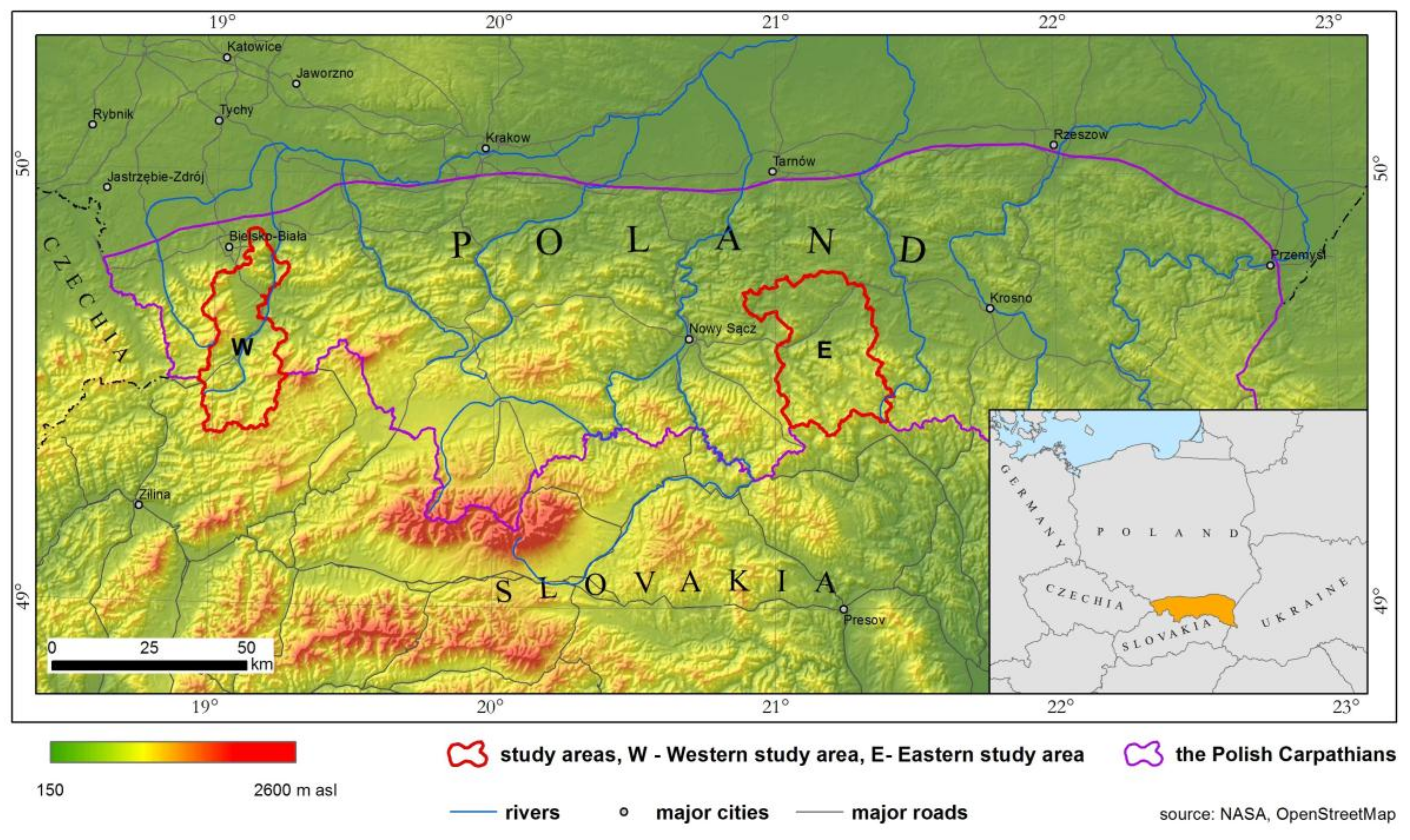
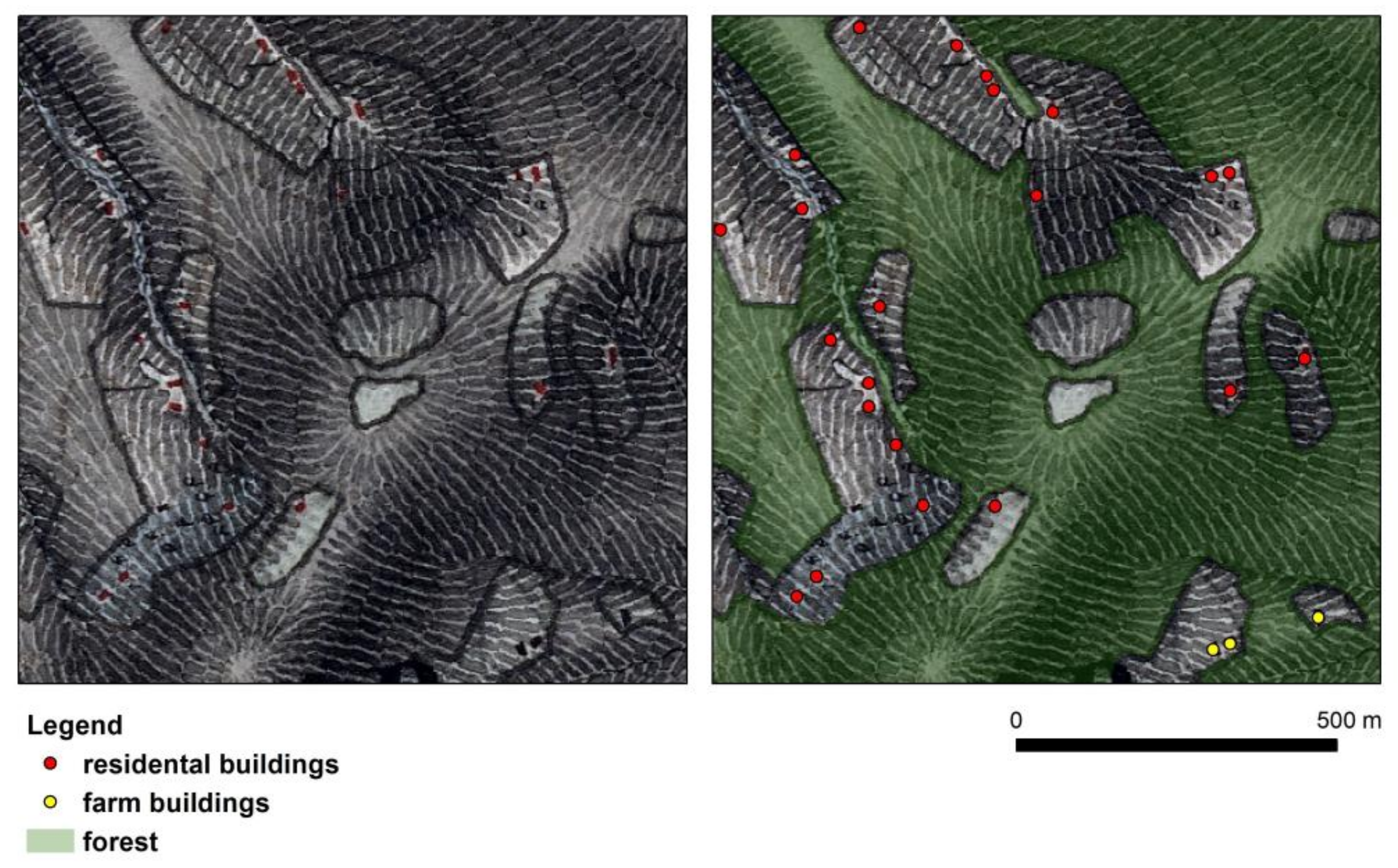
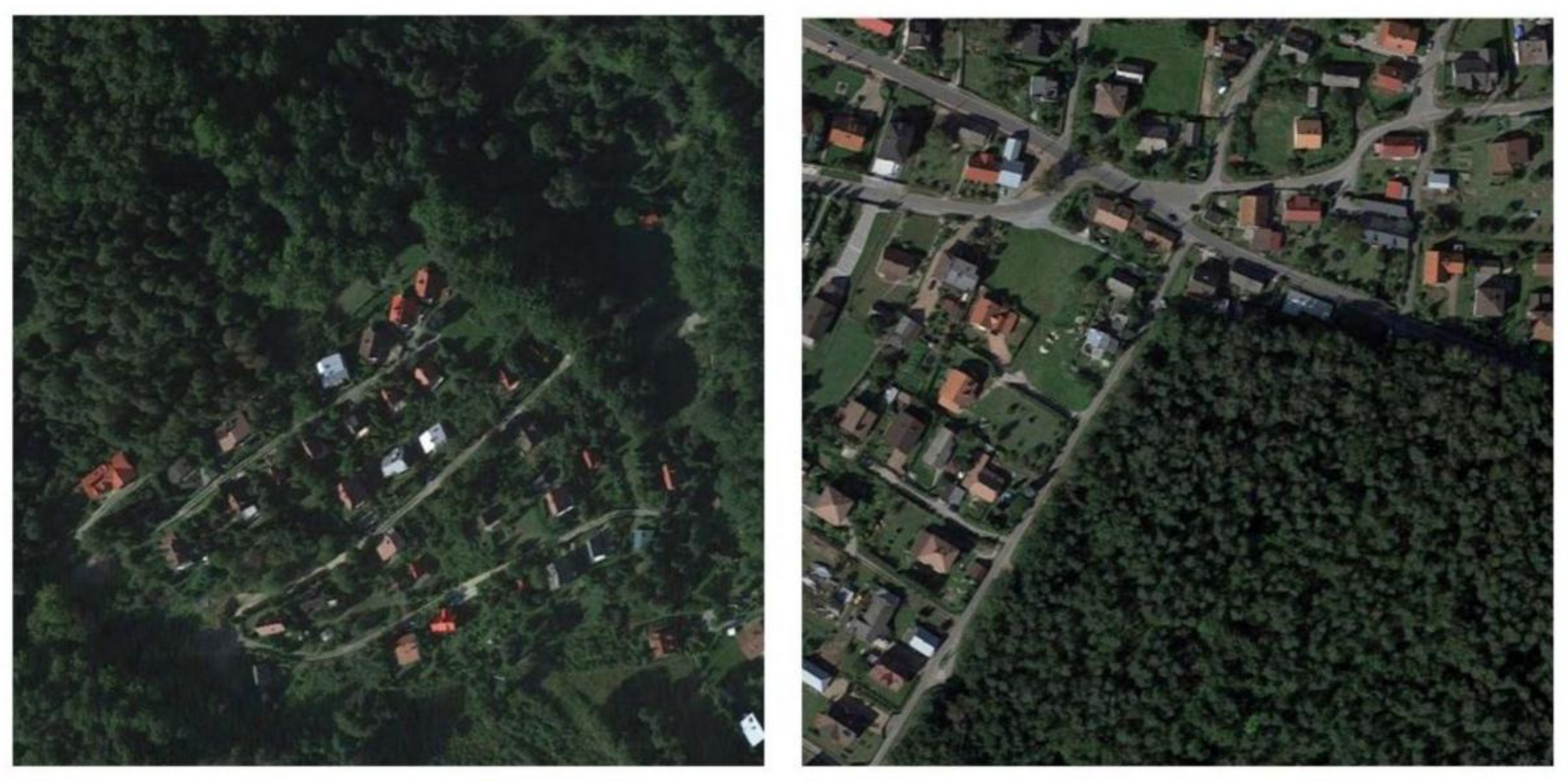
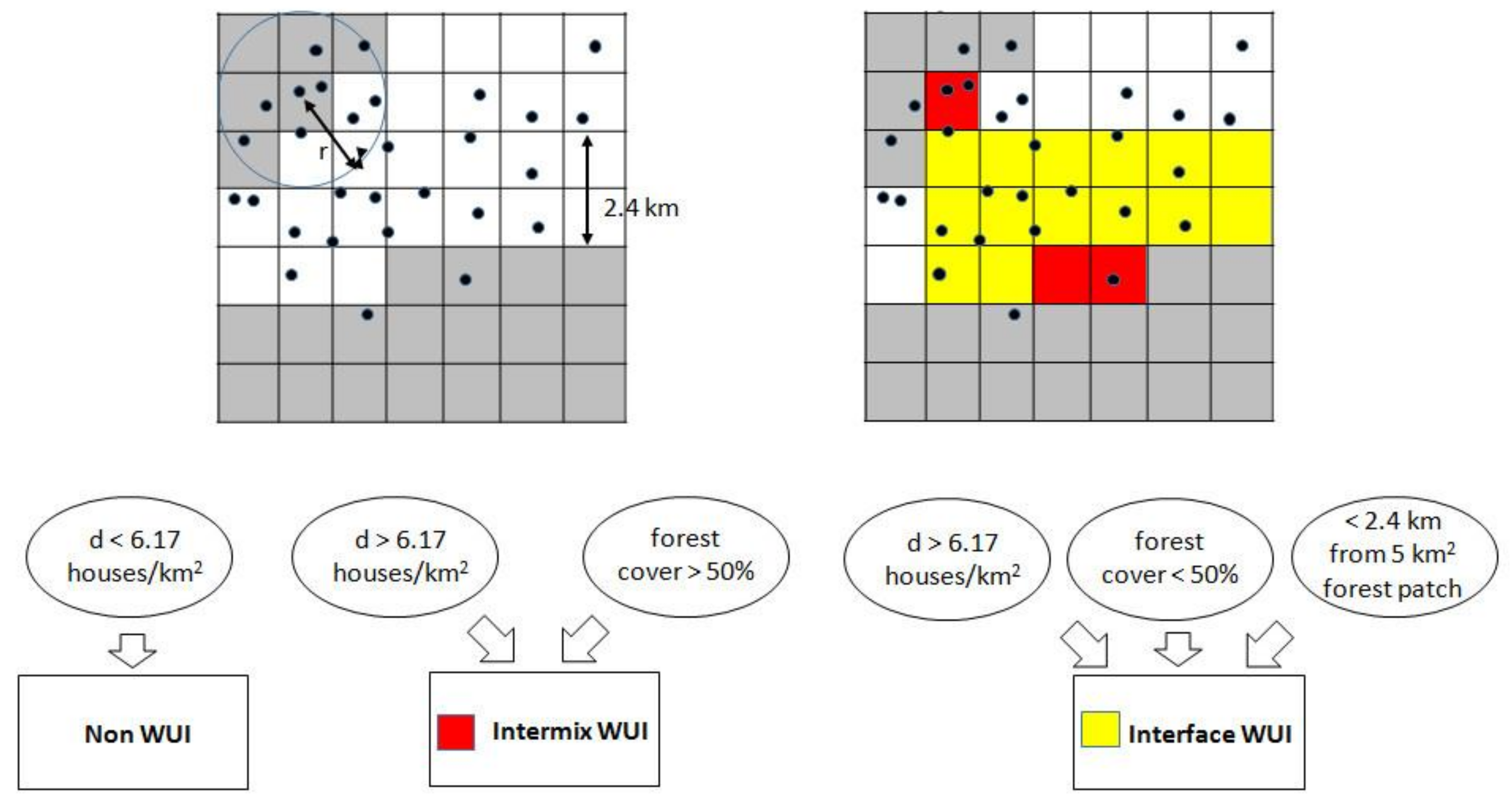
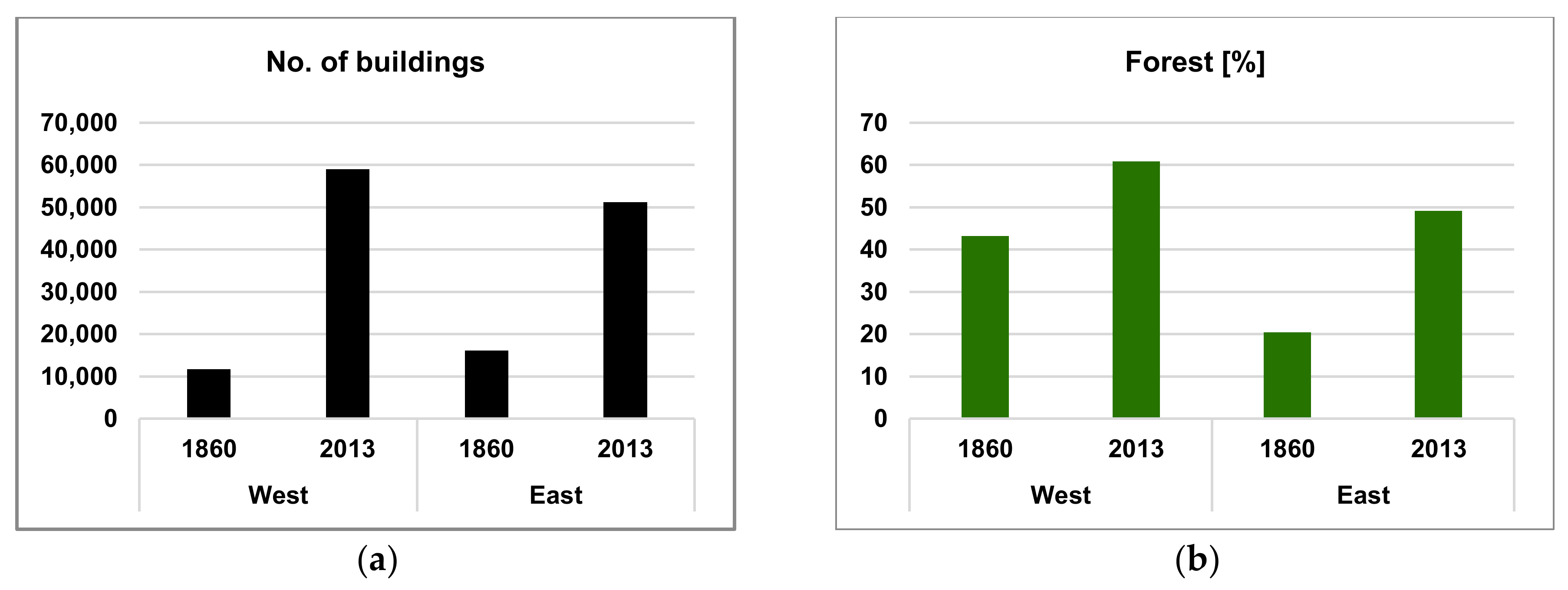

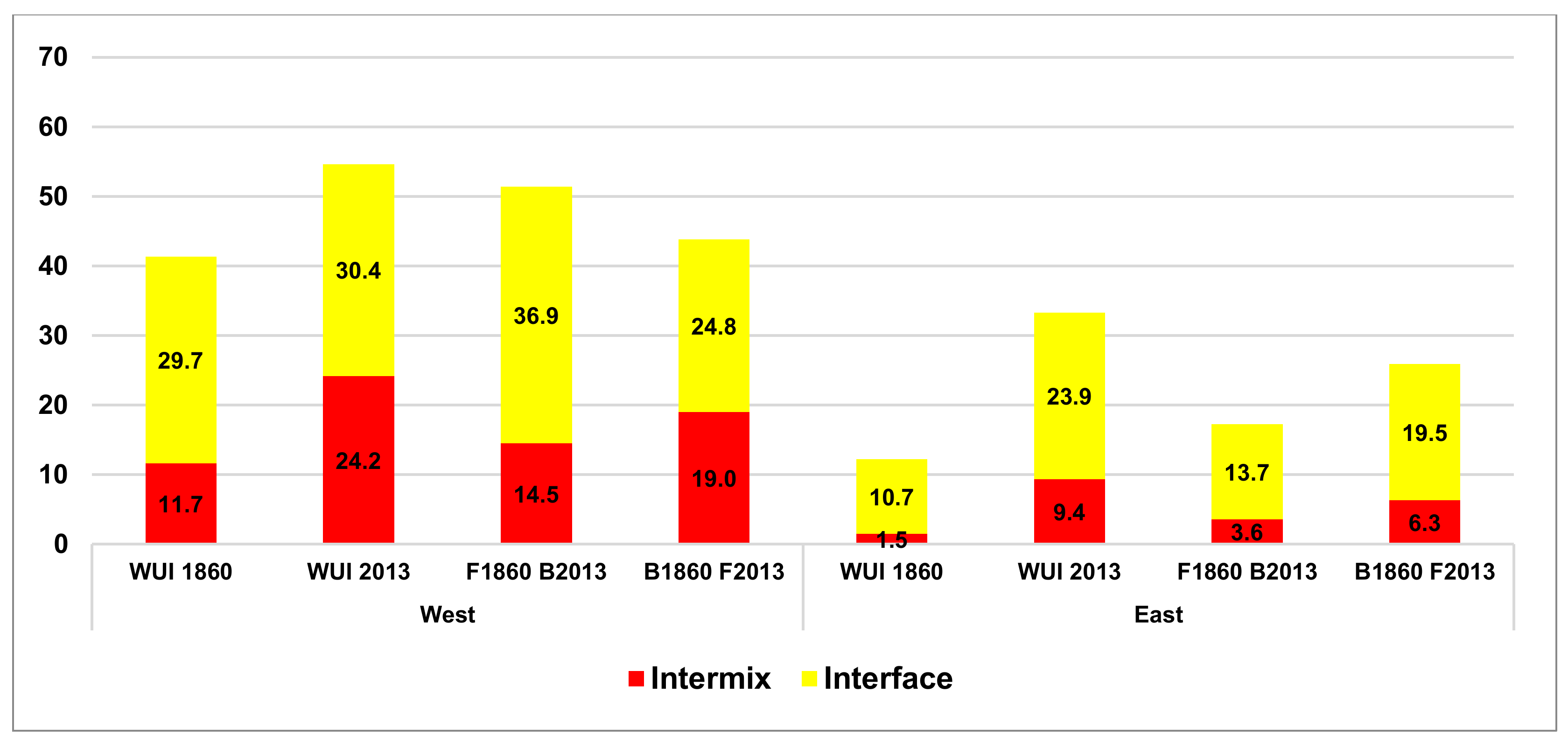
| Study Area | Year | Intermix WUI (%) | Interface WUI (%) | Total (%) |
|---|---|---|---|---|
| West | 1860 | 11.7 | 29.7 | 41.3 |
| 2013 | 24.2 | 30.4 | 54.6 | |
| East | 1860 | 1.5 | 10.7 | 12.2 |
| 2013 | 9.4 | 23.9 | 33.3 |
| 2013 | |||||
|---|---|---|---|---|---|
| Non-WUI | Intermix | Interface | |||
| 1860 | West | Non-WUI | 42.1 | 7.7 | 8.9 |
| Intermix | 0.6 | 22.4 | 6.7 | ||
| Interface | 2.7 | 0.3 | 8.6 | ||
| East | Non-WUI | 65.7 | 6.7 | 15.4 | |
| Intermix | 0.3 | 1.2 | 0.03 | ||
| Interface | 0.7 | 1.5 | 8.5 | ||
© 2018 by the authors. Licensee MDPI, Basel, Switzerland. This article is an open access article distributed under the terms and conditions of the Creative Commons Attribution (CC BY) license (http://creativecommons.org/licenses/by/4.0/).
Share and Cite
Kaim, D.; Radeloff, V.C.; Szwagrzyk, M.; Dobosz, M.; Ostafin, K. Long-Term Changes of the Wildland–Urban Interface in the Polish Carpathians. ISPRS Int. J. Geo-Inf. 2018, 7, 137. https://doi.org/10.3390/ijgi7040137
Kaim D, Radeloff VC, Szwagrzyk M, Dobosz M, Ostafin K. Long-Term Changes of the Wildland–Urban Interface in the Polish Carpathians. ISPRS International Journal of Geo-Information. 2018; 7(4):137. https://doi.org/10.3390/ijgi7040137
Chicago/Turabian StyleKaim, Dominik, Volker C. Radeloff, Marcin Szwagrzyk, Monika Dobosz, and Krzysztof Ostafin. 2018. "Long-Term Changes of the Wildland–Urban Interface in the Polish Carpathians" ISPRS International Journal of Geo-Information 7, no. 4: 137. https://doi.org/10.3390/ijgi7040137
APA StyleKaim, D., Radeloff, V. C., Szwagrzyk, M., Dobosz, M., & Ostafin, K. (2018). Long-Term Changes of the Wildland–Urban Interface in the Polish Carpathians. ISPRS International Journal of Geo-Information, 7(4), 137. https://doi.org/10.3390/ijgi7040137





